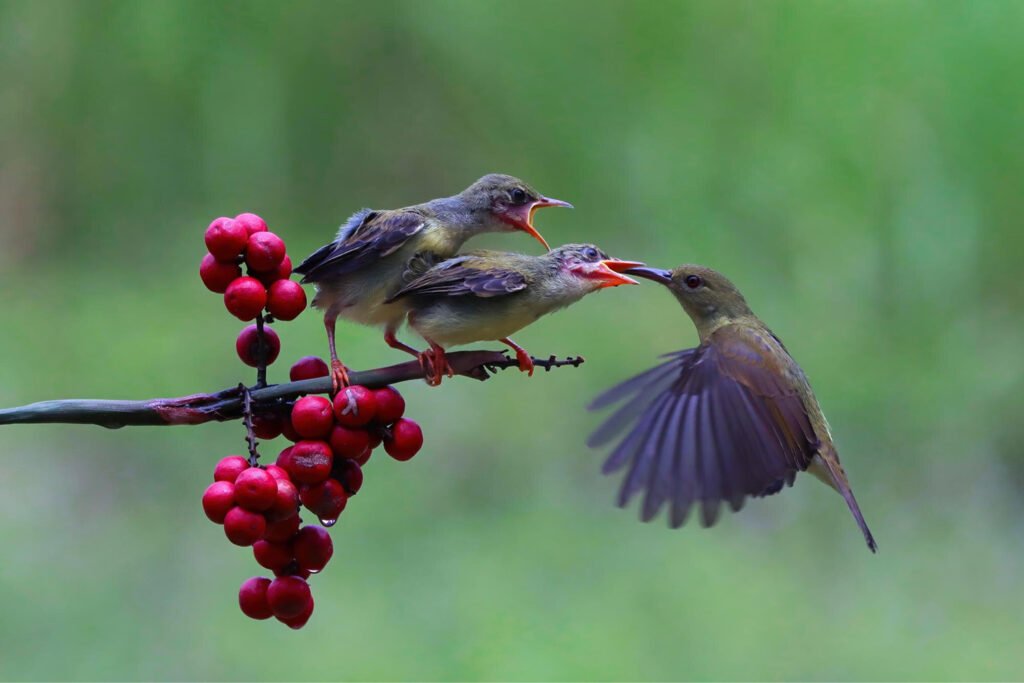What makes birds fiercely protect their turf while displaying vibrant songs and dazzling dances? Understanding bird territorial behavior offers insights into their survival tactics that influence both individual and species success. Birds stake claims not just for prime habitation but for survival, ensuring access to essential resources like food and mates. By grasping the intricacies of their territorial strategies, we unlock the keys to appreciating their ecological roles. Delving into this fascinating aspect of bird behavior, readers can gain a deeper appreciation of how these winged creatures maintain ecological balance and fortify their chances of reproductive triumph.
Methods Birds Use to Mark and Defend Territories
Marking territories is crucial for birds, especially in spring when migratory species return to breeding grounds. During this time, the establishment of territories ensures access to resources necessary for mating and raising young. The ability to effectively claim and defend a territory can significantly impact a bird’s reproductive success.
Birds employ various vocalizations as territorial markers. Songs are commonly used by many species to announce the presence and boundaries of a territory. These vocal signals serve a dual purpose: attracting potential mates and deterring competitors. Larger species, such as woodpeckers and grouse, utilize drumming as a territorial signal. The rhythmic sounds produced by pecking on resonant surfaces serve both as a call to mates and a warning to rivals. These vocalizations are a key aspect of territory defense, as they can communicate a bird’s presence over long distances.
In addition to vocal signals, birds use physical displays to assert territorial boundaries:
- Puffing plumage: Birds may fluff up their feathers to appear larger and more intimidating to potential intruders.
- Wing spreading: Extending wings is a visual display meant to assert dominance and mark territory limits.
- Tail fanning: Birds fan out their tails to enhance their size and posture, reinforcing boundary claims.
- Aerial displays: Some species engage in flight maneuvers to define territory spaces and intimidate rivals.
These methods are effective in deterring intruders, as they clearly communicate the presence of a territory holder. By combining vocal and physical displays, birds can maintain control over their territories, ensuring access to vital resources and minimizing conflicts with competitors. This comprehensive approach to territory defense is essential for survival and reproductive success in the avian world.
Interspecific Territoriality: When Birds Defend Against Other Species
Interspecific territoriality (IT) is a phenomenon where birds defend their territories against individuals of other species, reducing competition for shared resources. This behavior is significant as it enhances resource allocation efficiency and contributes to ecological stability by minimizing conflicts between different species.
The adaptive IT hypothesis proposes that interspecific territoriality is beneficial for species coexistence. By defending territories from other species, birds can ensure that their specific resource needs are met without having to specialize in different resources. This allows multiple species to occupy the same area without direct competition, thereby maintaining biodiversity. This hypothesis highlights the role of interspecific interactions in shaping community dynamics and promoting ecological balance.
Examples of interspecific territoriality include:
- Eastern and Western Meadowlarks: Though visually similar, these species exhibit IT through distinct songs, defending their territories from each other, especially in overlapping areas.
- Hummingbirds: Species like the Blue-throated Hummingbird defend territories from both conspecifics and heterospecifics, ensuring access to nectar sources.
- Marsh Wrens and Yellow-headed Blackbirds: Marsh Wrens exhibit aggressive IT by destroying the nests of Yellow-headed Blackbirds, a behavior driven by competition for nesting sites.
Studying interspecific territoriality offers valuable ecological insights. It reveals how species interactions influence habitat distribution and resource utilization. Observing IT can help identify patterns of coexistence and competition among bird species, providing a deeper understanding of ecological balance and the adaptive strategies birds employ to thrive in diverse environments.
Final Words
Understanding bird territorial behavior offers vital insights into their survival strategies and ecological balance. By exploring the methods birds use to mark and defend territories, one gains a deeper appreciation for their complex communication systems. Territorial claims play a crucial role in reproductive success, influencing nest-building and mate selection. Interspecific territoriality further highlights how birds manage interspecies dynamics to reduce competition. Employing observational techniques enhances both birdwatching experiences and scientific knowledge. This comprehensive understanding encourages a deeper appreciation for birds’ intricate lives and their environmental contributions.
FAQ
What does it mean when a bird is territorial?
A: Territorial behavior in birds refers to their actions to secure resources, such as food, mates, and nesting sites, ensuring survival and reproductive success.
How to deal with territorial birds?
A: Managing territorial birds involves respecting their space during nesting season, using visual or auditory deterrents, or relocating feeders to minimize confrontations.
What birds are extremely territorial?
A: Birds like robins, mockingbirds, and swans are known for their strong territorial behavior, often defending their area aggressively against intruders.
How long are birds territorial?
A: Birds typically remain territorial during breeding seasons, which can last from a few weeks to several months, depending on the species and environmental conditions.


